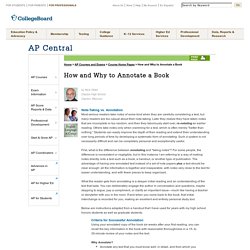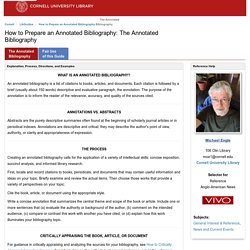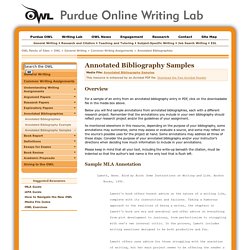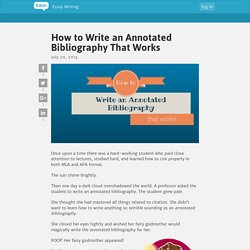

How and Why to Annotate a Book. Note-Taking vs.

Annotation Most serious readers take notes of some kind when they are carefully considering a text, but many readers are too casual about their note-taking. Later they realize they have taken notes that are incomplete or too random, and then they laboriously start over, re-notating an earlier reading. Others take notes only when cramming for a test, which is often merely "better than nothing. " Students can easily improve the depth of their reading and extend their understanding over long periods of time by developing a systematic form of annotating. Such a system is not necessarily difficult and can be completely personal and exceptionally useful. First, what is the difference between annotating and "taking notes"? What the reader gets from annotating is a deeper initial reading and an understanding of the text that lasts. Below are instructions adapted from a handout that I have used for years with my high school honors students as well as graduate students.
The Annotated Bibliography - How to Prepare an Annotated Bibliography. An annotated bibliography is a list of citations to books, articles, and documents.

Each citation is followed by a brief (usually about 150 words) descriptive and evaluative paragraph, the annotation. The purpose of the annotation is to inform the reader of the relevance, accuracy, and quality of the sources cited. Abstracts are the purely descriptive summaries often found at the beginning of scholarly journal articles or in periodical indexes. Annotations are descriptive and critical; they may describe the author's point of view, authority, or clarity and appropriateness of expression.
Creating an annotated bibliography calls for the application of a variety of intellectual skills: concise exposition, succinct analysis, and informed library research. Annotated Bibliography. Annotate Your Bibliography. The purpose of an annotation is to describe the cited material, whether a book, article or other type of source.

It is a brief, descriptive note that should provide sufficient information so that a determination can be made as to whether the source should be examined further for use. Annotations help to to clarify each source, and they will often provide evaluative information as well. Annotations are NOT book reviews. Be wary as you begin to write your annotations that you do not create a book review. An annotation also differs from an abstract, in that the abstract is simply a summary of the content. An annotation does not need to address each category below, but so far as possible, it should improve the decision making and simplify the researcher's work. Types of Annotations Informative Written in the tone of the book or article, an informative annotation presents the original material in a shorter form. Descriptive Evaluative Annotation Content Author Who is the author? Purpose Author Bias. Annotated Bibliographies. Summary: This handout provides information about annotated bibliographies in MLA, APA, and CMS.

Contributors:Geoff Stacks, Erin Karper, Dana Bisignani, Allen BrizeeLast Edited: 2013-03-10 11:25:28 Definitions A bibliography is a list of sources (books, journals, Web sites, periodicals, etc.) one has used for researching a topic. Bibliographies are sometimes called "References" or "Works Cited" depending on the style format you are using. Annotated Bibliographies. Overview For a sample of an entry from an annotated bibliography entry in PDF, click on the downloadable file in the media box above.

Below you will find sample annotations from annotated bibliographies, each with a different research project. Remember that the annotations you include in your own bibliography should reflect your research project and/or the guidelines of your assignment. As mentioned elsewhere in this resource, depending on the purpose of your bibliography, some annotations may summarize, some may assess or evaluate a source, and some may reflect on the source’s possible uses for the project at hand. Some annotations may address all three of these steps. Please keep in mind that all your text, including the write-up beneath the citation, must be indented so that the author's last name is the only text that is flush left. Sample MLA Annotation Lamott, Anne. Lamott's book offers honest advice on the nature of a writing life, complete with its insecurities and failures. Write - Writing an annotated bibliography. How to Write an Annotated Bibliography That Works - Essay Writing.
Once upon a time there was a hard-working student who paid close attention to lectures, studied hard, and learned how to cite properly in both MLA and APA format.

The sun shone brightly. Then one day a dark cloud overshadowed the world. A professor asked the student to write an annotated bibliography. The student grew pale. She thought she had mastered all things related to citation. She closed her eyes tightly and wished her fairy godmother would magically write the annotated bibliography for her. POOF! “I will grant your wish….well, sorta,” said the fairy godmother.
She wrote this blog post to teach all students how to write an annotated bibliography that works. What's an annotated bibliography?